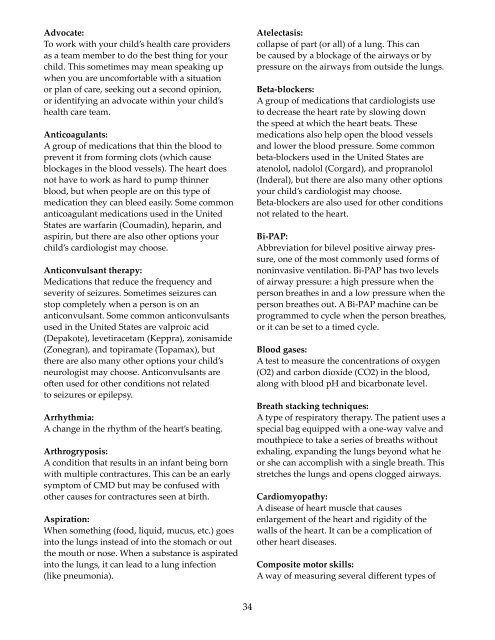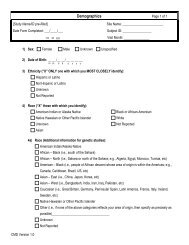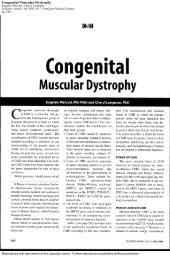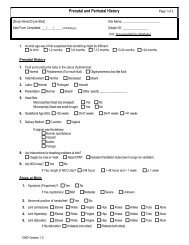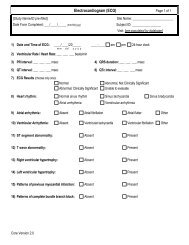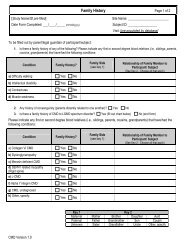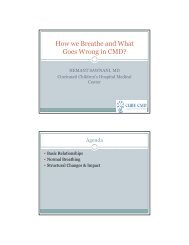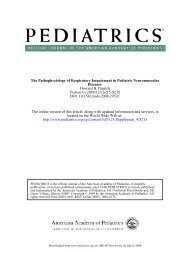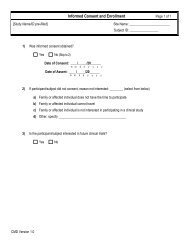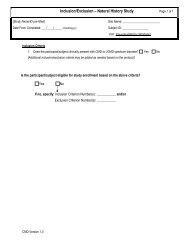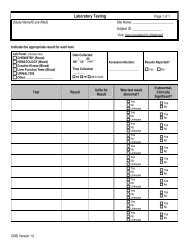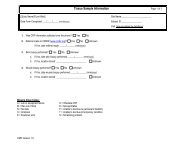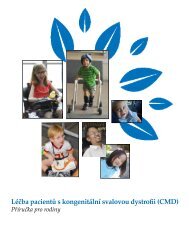The Management of Congenital Muscular Dystrophy ... - Cure CMD
The Management of Congenital Muscular Dystrophy ... - Cure CMD
The Management of Congenital Muscular Dystrophy ... - Cure CMD
You also want an ePaper? Increase the reach of your titles
YUMPU automatically turns print PDFs into web optimized ePapers that Google loves.
Advocate:To work with your child’s health care providersas a team member to do the best thing for yourchild. This sometimes may mean speaking upwhen you are uncomfortable with a situationor plan <strong>of</strong> care, seeking out a second opinion,or identifying an advocate within your child’shealth care team.Anticoagulants:A group <strong>of</strong> medications that thin the blood toprevent it from forming clots (which causeblockages in the blood vessels). <strong>The</strong> heart doesnot have to work as hard to pump thinnerblood, but when people are on this type <strong>of</strong>medication they can bleed easily. Some commonanticoagulant medications used in the UnitedStates are warfarin (Coumadin), heparin, andaspirin, but there are also other options yourchild’s cardiologist may choose.Anticonvulsant therapy:Medications that reduce the frequency andseverity <strong>of</strong> seizures. Sometimes seizures canstop completely when a person is on ananticonvulsant. Some common anticonvulsantsused in the United States are valproic acid(Depakote), levetiracetam (Keppra), zonisamide(Zonegran), and topiramate (Topamax), butthere are also many other options your child’sneurologist may choose. Anticonvulsants are<strong>of</strong>ten used for other conditions not relatedto seizures or epilepsy.Arrhythmia:A change in the rhythm <strong>of</strong> the heart’s beating.Arthrogryposis:A condition that results in an infant being bornwith multiple contractures. This can be an earlysymptom <strong>of</strong> <strong>CMD</strong> but may be confused withother causes for contractures seen at birth.Aspiration:When something (food, liquid, mucus, etc.) goesinto the lungs instead <strong>of</strong> into the stomach or outthe mouth or nose. When a substance is aspiratedinto the lungs, it can lead to a lung infection(like pneumonia).Atelectasis:collapse <strong>of</strong> part (or all) <strong>of</strong> a lung. This canbe caused by a blockage <strong>of</strong> the airways or bypressure on the airways from outside the lungs.Beta-blockers:A group <strong>of</strong> medications that cardiologists useto decrease the heart rate by slowing downthe speed at which the heart beats. <strong>The</strong>semedications also help open the blood vesselsand lower the blood pressure. Some commonbeta-blockers used in the United States areatenolol, nadolol (Corgard), and propranolol(Inderal), but there are also many other optionsyour child’s cardiologist may choose.Beta-blockers are also used for other conditionsnot related to the heart.Bi-PAP:Abbreviation for bilevel positive airway pressure,one <strong>of</strong> the most commonly used forms <strong>of</strong>noninvasive ventilation. Bi-PAP has two levels<strong>of</strong> airway pressure: a high pressure when theperson breathes in and a low pressure when theperson breathes out. A Bi-PAP machine can beprogrammed to cycle when the person breathes,or it can be set to a timed cycle.Blood gases:A test to measure the concentrations <strong>of</strong> oxygen(O2) and carbon dioxide (CO2) in the blood,along with blood pH and bicarbonate level.Breath stacking techniques:A type <strong>of</strong> respiratory therapy. <strong>The</strong> patient uses aspecial bag equipped with a one-way valve andmouthpiece to take a series <strong>of</strong> breaths withoutexhaling, expanding the lungs beyond what heor she can accomplish with a single breath. Thisstretches the lungs and opens clogged airways.Cardiomyopathy:A disease <strong>of</strong> heart muscle that causesenlargement <strong>of</strong> the heart and rigidity <strong>of</strong> thewalls <strong>of</strong> the heart. It can be a complication <strong>of</strong>other heart diseases.Composite motor skills:A way <strong>of</strong> measuring several different types <strong>of</strong>34


